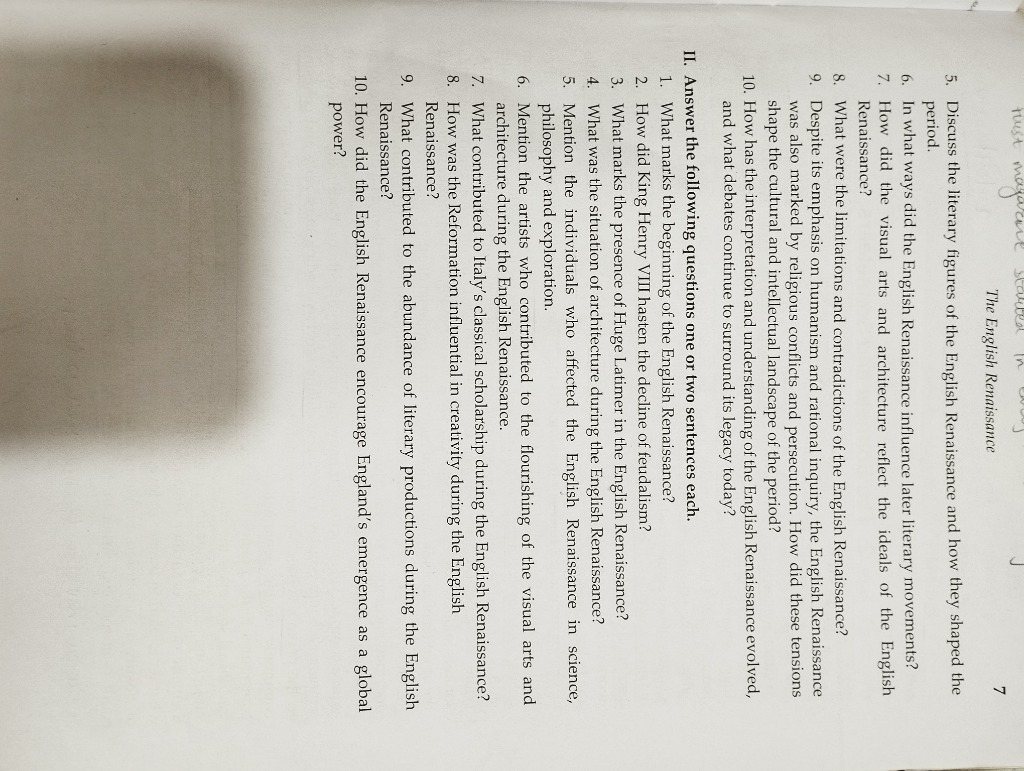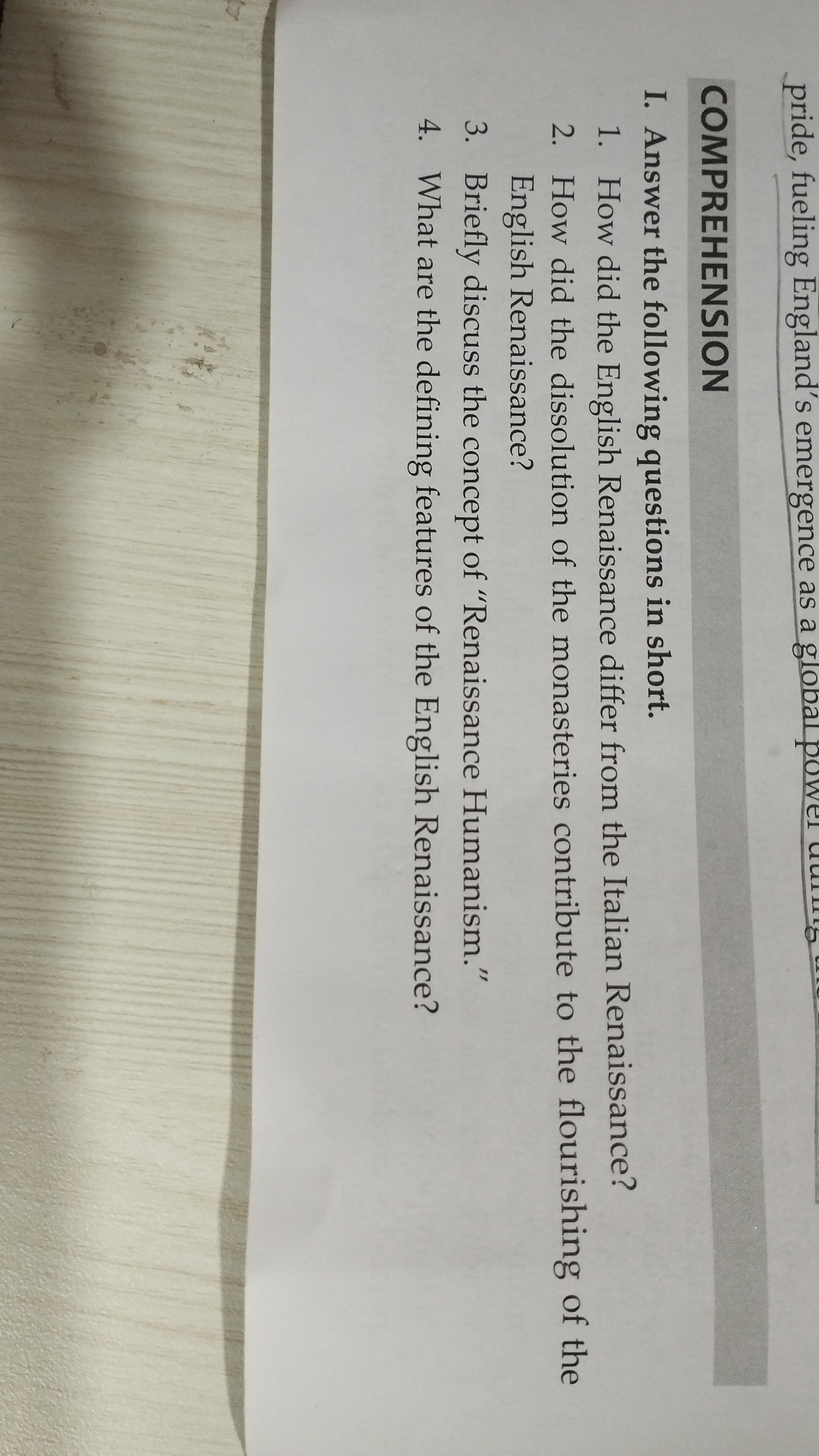Title: Insights into the English Renaissance's Cultural Impact
Notes on the English Renaissance

Overview
The English Renaissance was a cultural movement that marked a period of revival in art, literature, and intellectual inquiry, influencing many aspects of society. It was characterized by a fascination with classical antiquity, humanism, and advancements in scientific thought.
Key Questions and Insights
-
Literary Contributions
- The English Renaissance significantly shaped literature through the works of notable playwrights and poets, including William Shakespeare and Christopher Marlowe.
- Insight: This era introduced complex character development and themes of individualism and emotion, reflecting the humanist philosophy.
-
Influence of Italy's Classical Heritage
- Italian Renaissance thinkers and artists, like Dante and Petrarch, served as powerful influences on English writers, promoting a newfound appreciation for classical texts and aesthetics.
- Insight: The cultural exchange between Italy and England was pivotal in establishing a shared intellectual foundation.
-
Role of the Reformation
- The English Reformation provided a backdrop for the Renaissance by challenging established norms, which encouraged innovative thinking in literature and the arts.
- Insight: The church's transformation opened new avenues for artistic expression, allowing greater freedom in thematic exploration.
-
Abundance of Literary Productions
- The proliferation of printed materials due to the invention of the printing press facilitated the dissemination of literary works.
- Insight: This increase in accessibility democratized literature, empowering a broader audience and fostering literacy.
-
Tensions in Humanism and Inquiry
- The balance between humanism and religious dogma created tensions within the Renaissance, leading to debates about the roles of art and individual thought.
- Insight: Such conflicts underscored the complexity of the Renaissance, shaping its legacy in modern philosophical discourse.
-
Architectural Developments
- Architecture during the English Renaissance was influenced by classical styles, leading to a remarkable blend of new ideas and traditional forms, as seen in buildings like St. Paul's Cathedral.
- Insight: The revival of classical architectural principles signified a broader cultural embrace of classical ideals.
-
Visual Arts and Their Reflection
- The visual arts during this period incorporated classical themes, with artists capturing realistic human forms and dynamic compositions.
- Insight: Such developments emphasized the importance of observation and realism, laying the groundwork for future artistic movements.
-
Impact of Figures in the English Renaissance
- Key figures like Sir Thomas More and Edmund Spenser contributed to the flourishing of art and literature, reflecting the spirit of inquiry and progress.
- Insight: Their works often critiqued social issues of the time, showing the power of art as a form of societal reflection.
-
Legacy and Modern Interpretation
- The English Renaissance left a profound legacy, influencing contemporary literature, art, and cultural theory, as well as shaping modern views on creativity and individuality.
- Insight: Understanding this period helps contextualize current artistic practices within a historical framework of cultural evolution.
-
Global Emergence of England
- The advancements made during the English Renaissance helped establish England as a leading cultural force globally.
- Insight: This was crucial for the formation of a national identity, which continues to evolve in modern times.
Conclusion
The English Renaissance was a transformative period that reshaped literature, art, and thought. Its emphasis on humanism, classical ideals, and individual expression has had a lasting impact, continuing to influence modern cultural practices today.
Extended readings:
Comprehensive Notes on Artistic Renaissance

1. Answer the following questions in short.
2. How did the artistic features of the Renaissance contribute to the foundations of the modern world?
- Insight: The Renaissance marked a shift from medieval perspectives to humanistic views, emphasizing individualism and the study of classical antiquity.
- Additional Info: This era introduced techniques such as linear perspective, which helped create depth and realism in art, influencing architecture and design.
3. Briefly discuss the concept of Renaissance Humanism.
- Insight: Renaissance Humanism focused on the potential of individual achievement and the importance of education, leading to advancements in various fields such as literature, philosophy, and the sciences.
- Additional Info: Key figures include Petrarch and Erasmus, who emphasized classical texts and moral philosophy.
4. What are the defining features of the English Renaissance?
- Insight: The English Renaissance is characterized by advances in poetry, drama, and prose, with notable figures such as William Shakespeare and Christopher Marlowe.
- Additional Info: The period saw a flourishing of literary expression and exploration of human experiences, often combining classic themes with contemporary issues.
5. How did the English Renaissance differ from the Italian Renaissance?
- Insight: While the Italian Renaissance focused heavily on art and architecture, the English Renaissance emphasized literature and theater.
- Additional Info: The social, political, and economic contexts also varied, with England experiencing different societal transformations influenced by the Reformation.
These notes encapsulate key themes and insights regarding the Renaissance, focusing on its impact on modernity, humanism, and distinguishing features across regions.
Extended readings:
English Renaissance: Key Concepts and Discussions

1. Differences Between the English and Italian Renaissance
- Context: The Renaissance began in Italy during the 14th century before spreading to England in the late 16th century.
- Key Differences:
- Cultural Influences: The Italian Renaissance was heavily influenced by classical antiquity and humanism. In contrast, the English Renaissance incorporated elements of medieval traditions alongside classical influences.
- Literature & Arts: English literature saw significant contributions from playwrights and poets, like Shakespeare, emphasizing themes of human experience rather than solely classical motifs.
2. Contribution of Monastery Dissolution to the English Renaissance
- Impact:
- The dissolution of monasteries under Henry VIII (1536-1541) led to the redistribution of wealth and lands, fueling economic growth.
- Enabled the growth of private patronage for the arts and education, which played a crucial role in literary flourishing.
3. Concept of Renaissance Humanism
- Definition: Renaissance Humanism is a cultural movement that emphasized the study of classical texts and the value of human beings, encouraging education based on humanities.
- Insights:
- Focus on individual potential and achievements (human-centered).
- Shift from religious to secular perspectives in literature and philosophy.
4. Defining Features of the English Renaissance
- Key Features:
- Literary Flourishing: Emergence of influential playwrights and poets; flourishing of English drama and poetry.
- Scientific Inquiry: Advances in scientific thought, leading to the beginnings of the Scientific Revolution.
- Visual Arts: Evolution of artistic techniques and incorporation of naturalism.
- Religious Reformation: Impact of the Protestant Reformation on societal values and artistic expressions.
These points provide a framework for understanding the complexities and dynamic developments during the English Renaissance, showcasing its distinct characteristics compared to the Italian Renaissance while highlighting the transformative impact of the period on culture and society.
Extended readings: